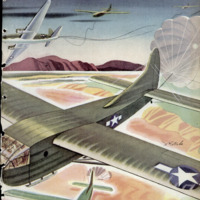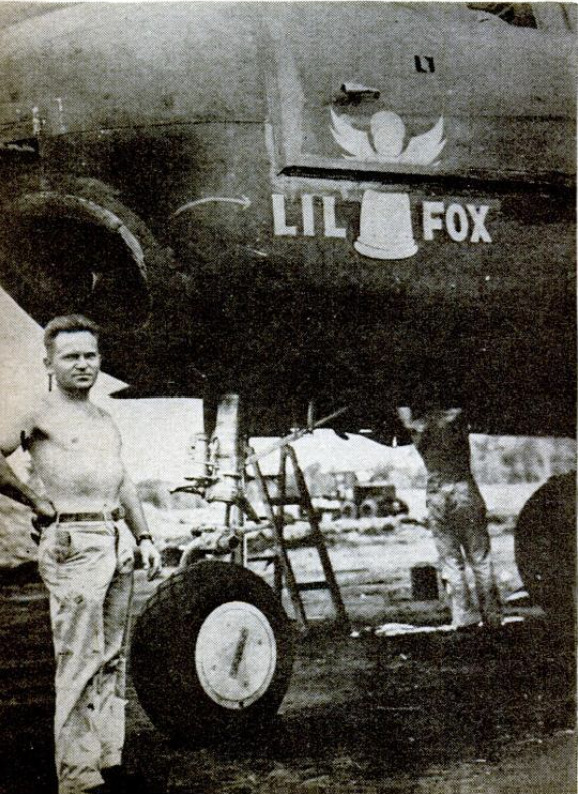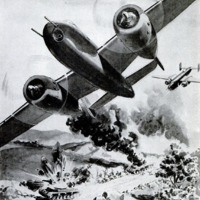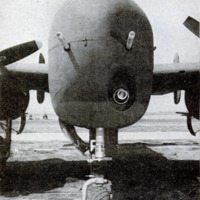-
Title (Dublin Core)
-
A 75mm aircraft cannon mounted on a medium bomber
-
Article Title and/or Image Caption (Dublin Core)
-
Title: Flying big gun
-
Subtitle: America gets the world's most powerful air weapon a cannon of fieldpiece caliber that goes into battle in a combat plane
-
extracted text (Extract Text)
-
AMERICAN planes now carry the aerial
firepower to back up any plans our
strategists may have for future air offensives!
Firepower, the peg on which air superiori-
ty hangs, has suddenly taken on new mean-
ing for American planes and pilots. The
reason is the achievement of a little group
of Ordnance and Air Corps experts who
have made a World War I dream come
true—the dream of carrying aloft in air-
craft regulation fieldpiece-caliber artillery.
Since the days of the Spad, the Camel,
and the Fokker D7, the armament of mili-
tary aircraft has undergone few really
radical changes. The old .30 caliber machine
gun has but recently given way to the .50
caliber gun developed by American experts
and used by our pilots and air gunners. The
first production air cannon firing an ex-
plosive shell was the 20-mm., only slightly
larger in caliber than a .50 machine gun.
Then came the 37-mm. cannon, around
which the Bell Airacobra was designed.
Some British planes now carry the 40-mm.
cannon, only slightly larger than the Aira-
cobra’s weapon. These guns have proved
highly effective, but our Ordnance men still
dreamed of arming a plane with a weapon
such as the most-used fieldpiece of World
‘War I, the French 75-mm. cannon,
Not until mid-November 1942 did their
plans bear fruit. The setting was far out
in the Pacific, off the California coast. A
plank-and-fabric target bobbed in the surf
directly in the glide path of a North Ameri-
can Mitchell bomber.
Suddenly, while the B-25 was still miles
away, its nose blossomed orange flame.
Gulls wheeling about the floating target
took no notice, for before the sound of the
gun could have reached them, they had
vanished along with the target in a great
upheaval of debris, water, and froth. Amer-
ica had a new aerial weapon—the world’s
deadliest aerial cannon, a flying “75”!
In the cockpit of the Mitchell, lanky Roger |
Rudd, North American test pilot—and, by a |
coincidence, a 75-mm.-gun crew captain in
the World War—relaxed his finger from the
red button on his control wheel. With a grin
he spoke through his throat mike to the
ground: |
“Rapping off over 200 in a mild glide . . . |
good husky jolt . . . scarcely any noise . . .
she doesn’t decelerate a damn bit!” |
That was Rudd’s report on the first pro- |
duction-model test of our new flying artil- |
lery. |
Since this first flight, the flying 75 has ap-
peared in ever-increasing numbers in the
South Pacific and probably in other theaters.
Its pilots came back |
from first missions
with combat reports
that read like pulp
fiction, and with awe
at what the new
weapon had done.
One cannon-carry-
ing plane on its first
mission destroyed a
Nip transport as it
was unloading, and
with one shell ended
the earthly worries
of 15 Japs scurrying
up the beach. On
its second mission it
ploughed five shots
into a large Jap de-
stroyer, hitting the
aft turret, bridge, amidship section, and
bow. Another run on it—now beached—
plastered a stack, the bridge again, and
the deck, and set off internal explosions.
The third mission resulted in the blasting
of runway strips and ground Jap planes,
along with the silencing of reinforced
pillboxes. The cost of all this was 90
rounds of ammunition and a few holes
from flak.
Other planes flying the 75 had similar suc-
cess, and pilots were jubilant over its effec-
tiveness against any type of ground installa-
tion or mechanized equipment. One shell
would completely destroy a light tank or put
the heaviest out of commission. It was equal-
ly deadly against landing barges, ammuni-
tion dumps, locomotives, and power plants.
The 75 has a range roughly the same as
that of the original French 75, with the ad-
vantage of being fired from an elusive plat-
form moving hundreds of miles an hour
through the air. Such a gun, hurling 15
pounds of concentrated destruction from any
angle in surprise attacks, does nothing to
calm the nerves of the enemy, no matter
how battle-tested.
Even in World War I, a few experiments
were made with heavy-caliber ordnance
mounted in aircraft. One of the outstanding
attempts was the Davis gun, a weird weapon
that fired through both ends of the barrel.
From one end came the projectile, while
from the other roared a charge of lead shot.
Sandwiched in between was the powder
charge. This crude arrangement was ex-
pected to overcome the major obstacle in
mounting heavy-caliber artillery in aircraft
—recoil. The Davis gun did overcome recoil
quite effectively, but the back charge of shot
had to be reckoned with when placing the
gun aboard, and the two-way shell was
clumsy to handle. A .30 caliber Lewis ma-
chine gun was mounted atop the contraption
and fired when approaching the target.
Tracers from the Lewis determined when
the cannon was within range of its objective,
for the range of the double-ended charge
‘was roughly the same as that of the machine
gun.
Eventually, the Davis gun was abandoned
as an aircraft weapon, and recoil remained
a stumbling block until American ingenuity
surmounted it many years later.
Shortly before 1939, first tests were made
with an old-style French 75 under the direc-
tion of Captain (now Colonel) Horace A.
Quinn, who was put in charge of the project
as Chief of the Aircraft Armament Develop-
ment Section of the Technical Division,
Ordnance, under
Colonel (now Major General) G. M. Barnes.
‘The gun was mounted in the fuselage of a
junked B-18 bomber and fired on the ground
to test the reaction of the fuselage to the
shock of such an explosion. These early
tests were successful, considering the crude
equipment.
Encouraged but still cautious, the Ord-
nance men next obtained flyable models of
the B-18 through the co-operation of the Air
Forces, and went ahead with the most dan-
gerous part of the experiment—flight-test-
ing and firing the old cannon.
In every case, Captain Quinn himself in-
sisted upon taking the risk of firing the first
rounds from these makeshift mounts, and
to his courage goes much credit for the final
outcome of these dangerous experiments.
Five different mounts for the old 75 were
tested, each more effective and lighter than
the last. These were developed through the
co-operation of the Watervliet and Rock
Island arsenals.
With traditional Ordnance caution, en-
thusiasm was curbed during further modifi-
cation until, in 1940, an improved model was
demonstrated before the Air Corps Board
at Eglin Field, Fla. As a result of this dem-
onstration, and under the direction of Colo-
nel Barnes as Chief of the Ordnance re-
search program, a number of industrial
companies were called in to help with de-
velopment and manufacturing problems.
‘Their wholehearted co-operation produced
a 75-mm. aircraft cannon more powerful
than even the old French 75, with a perfect-
ed recoil mechanism and mount that met
the peculiar requirements of aircraft instal-
lation. To Victor F. Lucht, an Ordnance De-
partment engineer, goes credit for develop-
ment of the recoil mechanism and the work-
ing out of the details that assured flawless
performance of the assembled gun.
After more extensive ground tests, the
new 75 was taken into the air under the su-
pervision of Ordnance personnel. Again
Captain Quinn came forward to take the
risks attending the first firing aloft. The
results justified these risks.
Now the problem was to find a suitable
plane to take this great Ordnance achieve-
ment into combat. As this cannon was a
fixed weapon, the ship to carry it nad to
have speed and maneuverability, with the
guts to stand not only the installation
weight but also the shock of firing. The
size of the installation, too, had to be con-
sidered, along with the necessary equipment
and accessories and a man to load the gun.
Several manufacturers were consulted. It
was a lucky break when North American
Aviation came forward to offer the Mitchell
B-25 bomber as the steed. Already it had
been battle-proved on every front. If it
would do, months would be saved in getting
the gun into combat.
By a happy design coincidence the Mitch-
ell was ideal. Along the left side of the fuse-
lage, under the pilot's compartment, it had
a tunnel used by the bombardier in getting
into his nose position. This might be just
the spot for the placing of the gun.
To North American, then, was given the
exacting problem of installing the 75 in a
combat aircraft for the first time. Com-
pany experts received the drawings of the
gun and installation in mid-August 1942,
and George Bussiere, staff engineer in
charge of ordnance, gathered his able as-
sistants about him and dug in for a session
of sweat and toll.
‘What they really had to work with were
the M-4 aircraft cannon and the M-6 air-
craft-type mount as developed by the U.S.
Army Ordnance Department. What they
had to achieve was the attaching of these
units to the Mitchell medium bomber.
First the group studied the Mitchell's
structure to see if it would do “as is.” It
would—on paper—for months before added
ruggedness had been built in to support the
nose wheel. Tests were made, and the con-
sensus was that she could “take it.”
To accommodate the gun muzzle, a mild-
steel port was fitted to the nose of the ship
at the end of the bombardier’s tunnel. The
nose itself was entirely enclosed in metal,
replacing the transparent sections in the
standard model. Above the cannon muzzle,
mountings for two .50 caliber machine guns
were fitted as auxiliary weapons, and the
necessary armor was added for safety.
During the next four months, test sections
of the altered fuselage were taken under
wraps to isolated sections of the California
coast for testing on a 200-yard range. Here,
in utmost secrecy, test firings were made
with loads ranging from half charges to
more than 115 percent of normal combat
charges. As the thunder of these explosions
died away, the sections were started back
for a final check at the factory, where the
verdict was pronounced with satisfied grins:
“She can take it—and plenty more!”
Just three months from the day when
Bussiere first opened the blueprints, test-
pilot Rudd was firing the 75 over the Pacific.
-
Language (Dublin Core)
-
eng
-
Date Issued (Dublin Core)
-
1944-02
-
pages (Bibliographic Ontology)
-
105-108, 222, 228
-
Rights (Dublin Core)
-
Public Domain (Google digitized)
-
Archived by (Dublin Core)
-
Lorenzo Chinellato
-
Marco Bortolami (editor)
 Popular Science Monthly, v. 144, n. 2, 1944
Popular Science Monthly, v. 144, n. 2, 1944






